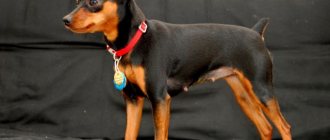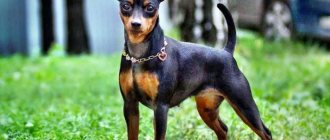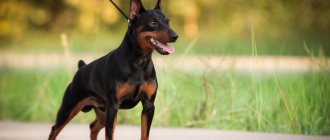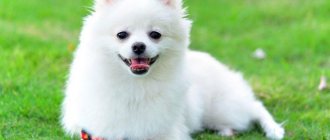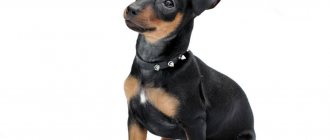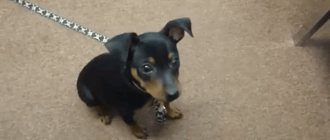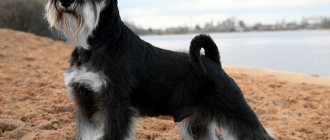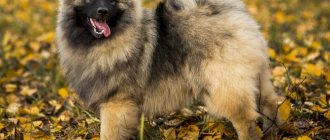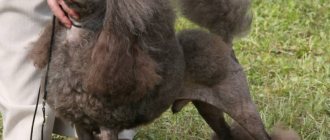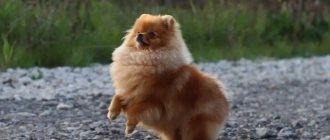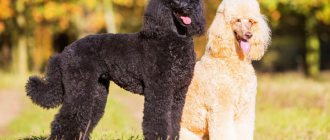The Miniature Pinscher is a small, cheerful dog that can become a devoted companion, accompanying its owner everywhere. Despite its small size, it is a strongly built, active dog, fearlessly rushing to defense and possessing protective qualities. The Miniature Pinscher is a very popular breed because it does not require serious care and is easy to train. But before you get such a pet, you need to study its description, character traits, reviews from owners, and the pros and cons of keeping it.
- Standard
- Miniature Pinschers Training
- Hygiene
Breed characteristics
| Short description | |
| Origin: | Germany |
| Conditions of detention: | In the apartment |
| Purpose: | Companions, guards |
| Color: | Black and tan, red |
| Wool length: | Average |
| Adult dog size: | The height of males is 25–30 cm, the height of females is 24–29 cm, the weight of males is up to 5 kg, the weight of females is up to 4 kg |
| Average life expectancy: | 15 years |
| Walk: | Twice a day, at least 45 minutes |
| Physical activity needs: | Average physical activity needs (walking 1 to 3 hours per day) |
| Fédération Cynologique Internationale (FIC) classification: | Group 2: Pinscher and Schnauzer, Molosser, Mountain and Swiss Cattle Dogs; Section 1: Pinschers and Schnauzers |
| Puppy price: | Show class – 25 – 30 thousand rubles, breeding class – 15 – 20 thousand rubles, pet class – 10 – 15 thousand rubles, without class up to 10 thousand rubles |
Varieties
The Miniature Pinscher dog breed itself is not divided into varieties. In fact, she herself is a subspecies in the extensive pinscher family. The closest relatives of miniature pinschers are dogs of the following breeds.
- Doberman. The external double of miniature pinschers, only two to three times taller and much heavier. It is curious that the largest variety in the family was bred later than all others - towards the end of the 19th century. It can be assumed that the famous service qualities of Dobermans are the result of pinscher origin, and were inherited by these giants from their smaller brothers.
- German Pinscher. It became isolated as a breed at the end of the 18th century. A medium-sized type of pinscher that participated in the breed selection of other subtypes.
- Affenpinscher. Also a dwarf subspecies and the only long-haired representative of the family, although it was not bred for beauty, but as a pest fighter. Known since the beginning of the 17th century.
- Austrian Pinscher. A young subspecies, relative to the history of the breed, bred in Austria to protect farms from rodents. Has a long coat and medium size.
History of the origin of the species
The Miniature Pinscher breed is considered one of the most ancient. The ancestors of these dogs lived in the early Middle Ages in the central part of Europe, or more precisely, in the territory of modern Germany. So, back in the middle of the 11th century, Czech warriors, who are considered relatives of German pinschers, were kept at the court of one of the Polish monarchs.
Some experts suggest that the history of miniature pinschers dates back to an earlier period and that the ancestors of modern dogs, the so-called Canis familiaris palustris, or turf dogs, lived on the European continent before the 4th century BC.
Work on the selection and breeding of dwarf pinschers, which was based on selection for exterior and working qualities, began to be carried out in the middle of the 19th century. The breed standard was created in 1880 by breeder R. Strebel. And 15 years later the Pinscher Club was founded.
As for the name of the breed, many experts agree with the assumption that the word “ Pinscher ” comes from the verb “ to pinch ,” which translated from English means “ to pinch, squeeze .”
Simple conclusions for the owner
To raise a well-mannered and obedient puppy, you need:
- Engage with him in studying and executing commands.
- Set clear and understandable rules.
- Solve problems that arise during the education process.
- Insist on.
- Don't be afraid to use physical punishment.
- Remember that you can never have too many positive emotions and games.
- Show your dog confidence in his abilities.
- Believe that if you work and put in a lot of effort, success will come.
And the most important thing to always remember is not to worry about small failures or difficulties. After just a short period of time, you will be surprised by the positive changes in the character of your pupil. You just need to work while maintaining optimism and a good mood.
Distinctive features
The characteristic features of the Miniature Pinscher are athleticism and slimness, an elegant physique combined with well-developed muscles.
- The body is strong, muscular and dry, the chest is deep and square in shape. The body is compact due to the small distance between the costal arch and the thigh.
- The head is not wide, has the outline of a triangle. The skull is oblong, the transition to the neck is smooth. The forehead is smooth, flattened, and has a pronounced transition line to the nose. The muzzle tapers towards the nose.
- The neck is elongated, distinguished by the presence of a graceful bend at the point of transition to the withers. There are no folds or dewlap at the neck.
- The ears sit high and have a triangular shape. They can stand or be hanging. Ear cropping is allowed. But this procedure is not mandatory for miniature pinschers.
- The eyes are almond-shaped and expressive. Most often they express the animal's wariness. Set wide apart. Their color is certainly dark, and the pigmentation along the edges of the eyelids is also dark.
- The nose is colored black.
- The jaws are strong and have a scissor bite. Cheekbones are not prominent, but well developed. The lips are tightly closed and dark in color.
- The limbs are straight, with well-developed muscles. They are of medium length and not placed close together. Locks are positioned correctly. In terms of the structure of their paws, miniature pinschers are similar to cats - the toes are arched, tightly closed, and have black claws.
- The tail is set high. It can be docked, but more often remains natural. When docked, its length is 12–20 mm.
- The coat is short and hard, shiny. He cannot disguise the shortcomings of the dog’s physique. At the same time, it reveals the severity of the lines and athleticism of the body.
- Color , according to standards, can be of two types: black and tan or fawn (red). Animals of black and tan color have smooth, black fur, with clearly defined tan markings, which are located on the paws, neck, chest, above the eyes, inner thighs and under the tail. The red color can be of different saturation, without tan marks.
Photo of an adult dog
Photos of puppies
Features of character and behavior
Miniature pinschers are independent, stubborn, self-confident, willful animals . At the same time, they are distinguished by their devotion to their owner and sociability. Dogs cannot tolerate excess caresses and stroking. The ideal owner for them is an energetic person leading an active lifestyle.
Animals have developed intelligence; they can learn some commands after several repetitions. They get along well with children, without allowing rudeness and bullying.
But with other pets they are often aggressive. Miniature pinschers often get into fights with animals that are larger than them. This is explained by the desire for dominance. Distrust and wariness also manifests itself in relation to strangers. Their dogs are often greeted with loud barking. Despite their modest size, they are able to protect themselves and their owner.
Advantages
The advantages of the breed include:
- Devotion;
- High intelligence and learning abilities;
- Security qualities.
Flaws
- The desire to dominate;
- Wayward character;
- They cannot stand loneliness and express their protest by gnawing on things;
- Need serious training;
- They bark often;
- During walks they can run away from their owner.
Interesting Facts
Miniature pinschers are among the smallest representatives of pinschers. However, they are distinguished by stubbornness and willfulness, which are not characteristic of even a large and strong Doberman.
Miniature pinschers are excellent manipulators. The owner often does not realize this quality of his four-legged friend.
Miniature pinschers are the best friends for energetic schoolchildren and teenagers. It is impossible for children and the elderly to keep up with an active pet, much less walk and raise a smart but wayward dog.
Due to their excessive activity, miniature pinschers are considered by many to be hysterical animals. However, their nervous system is in perfect order. They are balanced, but very playful and restless. It's just a character trait.
The miniature pinscher strives to be a leader among other pets and to be on an equal footing with its owner.
The educational process of a miniature pinscher should never stop. Otherwise, the mini Doberman will relax and stop listening to the owner.
Care and maintenance
Caring for miniature pinschers is easy.
- Bathing these dogs is not recommended as it can cause illness. The only exceptions are severe pollution. Since the claws of small dogs are difficult to grind down, they must be periodically shortened using special pliers.
- Staying in the cold or draft without additional insulation is extremely undesirable for miniature pinschers. In light frosts, animals can be walked without special clothing, as they are quite mobile. At a temperature of 7–10 degrees , dogs' paws can freeze, so if it gets significantly colder, warm clothes and boots are essential.
- You should be attentive to your pet’s well-being even during the heat. Animals can get sunstroke. To avoid this, their fur must be moistened with water from time to time.
- Miniature Pinschers' ears can be cropped or left in their natural state. Their care varies. Cropped ears remain clean and only need to be inspected once a week. Semi-drop ears require special care. Several times a year, to dissolve wax and dirt, you need to pour a special solution into the ears and massage the lower part of the ear for half a minute. The leaked liquid can be removed with a napkin.
- Hygienic procedures are also necessary for the pet’s oral cavity , since tartar deposited on the teeth can lead to disease. To prevent the formation of tartar, it is recommended to brush your teeth once a week.
Nutrition
Miniature pinschers are not picky eaters . Both dry food and natural food are suitable for them. But mixing these types of nutrition is not recommended. In addition, it is important to train your pet to eat at the same time of day, as well as constantly provide it with water.
- The menu of adult animals must include meat products (beef and offal). Their share in the diet should be at least 30%.
- of porridge (buckwheat, oatmeal, millet porridge) and fresh or stewed vegetables should be approximately the same .
- Vitamin and mineral complexes are given as supplements
- Eggs are useful , 1 – 2 pieces per week.
Puppies have a slightly different diet. About 60% of your food intake should be protein-rich foods. These are meat, chicken, fish, dairy products. The remaining 40% consists of cereals and vegetables.
The number of feedings depends on the age of the pet:
- 1 – 2 months – 6 times a day;
- 3 months – 5 times a day;
- 4 months – 4 times a day;
- 5 – 6 months – 3 times a day;
- 6 months and older – 2 times a day.
Miniature pinschers should not be fed pork and lard, salty and sweet foods, tubular bones, and legumes.
Health
Veterinarians call miniature pinschers the longest-lived among all dog breeds . According to statistics, their life expectancy is on average 12–16 years . And yet there are some health problems that are typical for representatives of this breed. The dog owner should first of all pay attention to these difficulties. Thus, miniature pinschers are prone to obesity, so it is necessary to monitor their diet and amount of food.
Vaccinations
Diseases against which pets need to be vaccinated:
- enterovirus;
- hepatitis;
- parvovirus;
- rabies;
- leptospirosis.
These are the most dangerous diseases, the course of which can be fatal. A veterinarian can draw up a schedule of preventive vaccinations . Although it may seem more acceptable to owners to administer a single polyvalent vaccine, this is not advisable. It is too heavy for the developing immune system. Vaccination takes place in several stages:
- The first vaccine against enteritis and hepatitis is administered to puppies at the age of 8–9 weeks , and the second one at 12 weeks . Revaccination is performed another year later .
- At 2.5 months, a vaccination against distemper .
- In the second half of the year, the rabies vaccine can be administered and then repeated every year.
The general rules for preparing for vaccination are as follows: 14 days before vaccination, the dog must be wormed and treated for ticks and fleas. Immediately before administering the vaccine, it is necessary to examine the dog and measure its body temperature.
As a rule, miniature pinschers tolerate preventive vaccinations easily. The owner should be alerted to an increase in temperature, the appearance of vomiting or convulsions, and increased breathing.
Diseases
Representatives of the breed are characterized by the following diseases:
- Diabetes mellitus, manifested by frequent urination and skin lesions.
- Urolithiasis disease. Its symptoms include frequent painful urination and cloudy urine.
- Corneal dystrophy. It becomes less transparent.
- Pannus, or proliferation of tissues of the third eyelid and cornea.
- Glaucoma, which can lead to blindness.
Walk
Miniature Pinschers need daily walking. Even if the dog lives in an apartment and is trained to go to the tray, being naturally energetic and active, it needs physical activity.
You need to walk your pet at least twice a day for 45 minutes. A good way to spend time outside, which miniature pinschers love, is games. For example, you can play Frisbee with your dog.
Grooming
Representatives of the breed have short hair, so it should not be brushed too often. During shedding, this should be done once a week using a brush with medium-hard bristles. Dead hairs can be removed with a slightly damp towel.
Pet's communication with the external environment
After the start of regular walks, the puppy’s socialization begins. To practice commands, it is better to choose deserted places where the dog will not be distracted by anything. But it is also necessary to walk with the puppy in crowded places, as well as places where other dogs are walked, so that he gets used to it and is not afraid of the noise of the streets and communication with his relatives.
Keep in mind that the social side of your pet’s life includes your company. The miniature pinscher, especially the small one, does not like loneliness, so gradually accustom him to being at home without his owners. Your first sudden exit from vacation to work may end in your apartment being destroyed by a bored dog.
Miniature pinschers can be trained from four months of age - this is a kind of adolescence, when the puppy develops character and the service qualities inherent in nature. The period is not easy, the dog gains self-confidence and may try to be cunning and manipulate its owner.
At four months of age, miniature pinschers grasp everything new almost on the fly. If you find the right motivation and organize activities in the form of active games, your pet will be more easily disciplined and will learn the necessary skills. It’s better to take a few lessons from a professional dog handler, who will tell you how to communicate more effectively with the animal.
Mating
When breeding miniature pinschers, the main task of breeders is to improve the qualities and eliminate the shortcomings of the breed . It is better to allow strong, healthy animals, with the correct structure of the limbs and developed bones, to be mated.
- Bitches can be mated for the first time after their second heat, not earlier than 15 months ; males - at one year of age .
- The frequency of mating is no more than once a year. The maximum age for a dog suitable for mating is 8 years .
- The female miniature pinscher is ready for mating on the twelfth day of estrus . Dogs are bred in the male territory. The guest first growls at her partner and often tries to bite him. Therefore, you can invite a specialist instructor for mating or make do with the presence of the owners.
- In order to prevent unforeseen situations and injuries, the owner of the bitch must be close to her, especially when mating occurs for the first time.
Key points in training
Training for miniature pinschers is very important, as the dogs have a capricious and domineering character and often display aggression towards strangers. There is no need to delay your studies. Well-developed intelligence allows you to start training from an early age.
If the owner misses time or shows the dog his weakness, the dog will quickly take advantage of this and try to become a leader in the relationship with the person.
During the training process, the owner will need a collar and leash, as well as toys and tasty treats. You can start training your puppy at the age of 3 – 4 months . The dog’s psyche at this time is mobile, the animal easily perceives new things.
Before you take your puppy for a walk, you need to introduce him to the collar. It’s enough to dress him up like a pet at home and let him walk around a little. The same applies to leash learning.
Puppies love to chase toys. This hobby can easily be turned into training by training the “fetch” command. For each correctly performed action, the pet should receive a treat. Other commands that a miniature pinscher should know and perform are “near”, “to the leg”, “sit”, “voice”, “lie down”, “front”, “fu”.
Miniature Pinschers are capable of learning more complex commands: “die”, “hold”, “crawl”. Training is a slow process, so it is better to conduct classes in a playful way.
Read about how to properly train a dog in the article: “Training a puppy: effective methods from dog handlers, learning commands at home.”
What you need to know
Before starting to work on the character of his pet, the owner needs to find out what qualities a puppy must have in order to be called well-mannered and obedient. The processes of training and education have a close relationship. Training includes learning to unquestioningly carry out simple commands. You can start it immediately as soon as the puppy appears in the house (regardless of its age) and the equipment and necessary things have been purchased for it. Education involves the formation of a clear hierarchy in the family, an understanding of what the owner’s behavior should be towards the dog.
We cannot ignore everything that a well-mannered puppy and its owners should know:
- If owners want to solve difficulties associated with their pet’s behavior, they must learn the main rules of upbringing. Failure to comply with these principles becomes the main reason for their appearance.
- One of the most important skills for a pet is toilet training outside or in a certain place in the house. The puppy will not be able to deal with these issues on his own. He can acquire this skill only through training. You need to start developing good toilet habits as early as possible. And the more correct the chosen training tactics, the faster you will be able to achieve stable results.
- You need to train your pet from the moment it starts living in your home. At a minimum, he should learn and follow basic commands.
- Puppy owners can face many difficult situations. For example, if a baby fawns over strangers, they begin to fear that he will not be able to become a reliable protector. Or, perhaps, the puppy bites when trying to feed and during play. Other pets may pick up crap from the floor or flatly refuse to listen to you. If you pay attention to different aspects of education, you can solve such problems.
How to choose a puppy
- When buying a miniature pinscher puppy, it is important to pay attention to its parents. They should not be overly aggressive or excitable.
- Experience shows that if a puppy was taken from its mother at an early age, it is capable of very quickly and strongly becoming attached to a person. In this regard, you can purchase miniature pinscher puppies starting from the age of one month.
- The animal must show activity, curiosity and at the same time balance of character. His eyes should be clean and shiny, his coat should be smooth, of the correct color, and his limbs should be even.
The basis of the educational process
How correctly the puppy will be raised depends on the owner’s persistence, the amount of time spent and love for the pupil. There must also be strict control. Just because you love your pet does not mean that he cannot be punished for pampering or trying to eat something harmful from the floor or the ground. The best owner for any dog is a strong, demanding, but kind dad.
There are several important and effective secrets of proper upbringing:
- If the puppy deserves physical punishment, there is no need to make concessions. The type of punishment will have to be applied at the beginning of education. In the future, the dog will wean itself from doing bad things and will know that at the first request it needs to execute the “fu” command. You should not lose sight of the fact that until the age of 3 months, a pet cannot be raised using physical punishment. At a tender age, parenting methods should be extremely careful.
- The baby should receive as many positive emotions as possible from the owner. The pet takes negative emotions and punishment for granted if they are appropriate, and the owner does not forget to praise his pupil. It is worth encouraging the puppy, for example, when he correctly followed the command, went to the toilet in a special place. Many owners pet their dogs even without achievements. If you use this gesture of attention more often, the contact between the owner and the puppy becomes closer.
- If you took a puppy to become a friend, a protector, then you need to take into account that loyalty is the quality of those dogs that consider their owner a member of their pack. Then the dog is really ready to give his life so that you can be saved.
Overly cruel and demanding owners will not be able to raise a reliable protector. This does not mean that you can allow people to sit on your neck. The principle of the golden mean is to initially praise the kids as often as possible, and over time, praise and encouragement with treats for following commands will be needed much less often.
Reviews from miniature pinscher owners
With good upbringing and care, the puppy will grow into a devoted, sociable, inquisitive pet who will serve its owner as an excellent companion and reliable guard for many years.
5 / 5 ( 1 voice )
